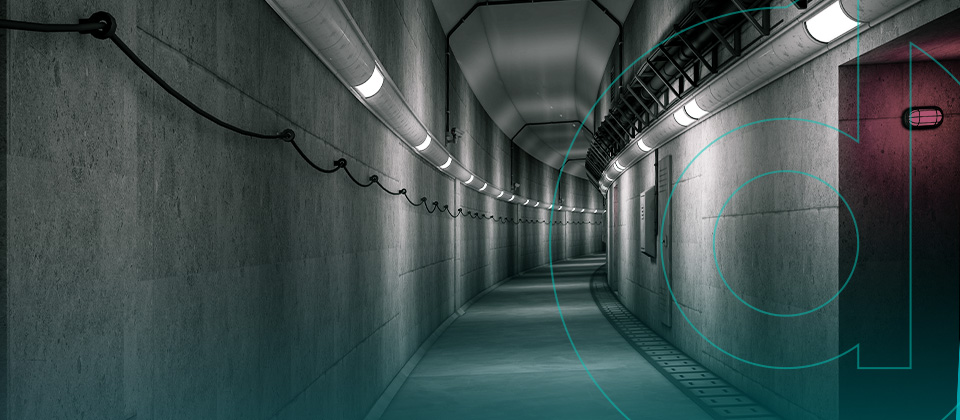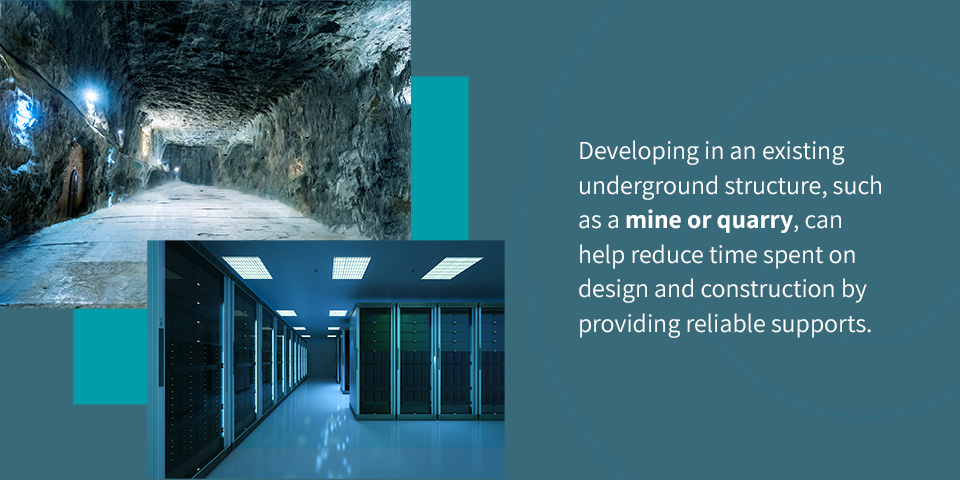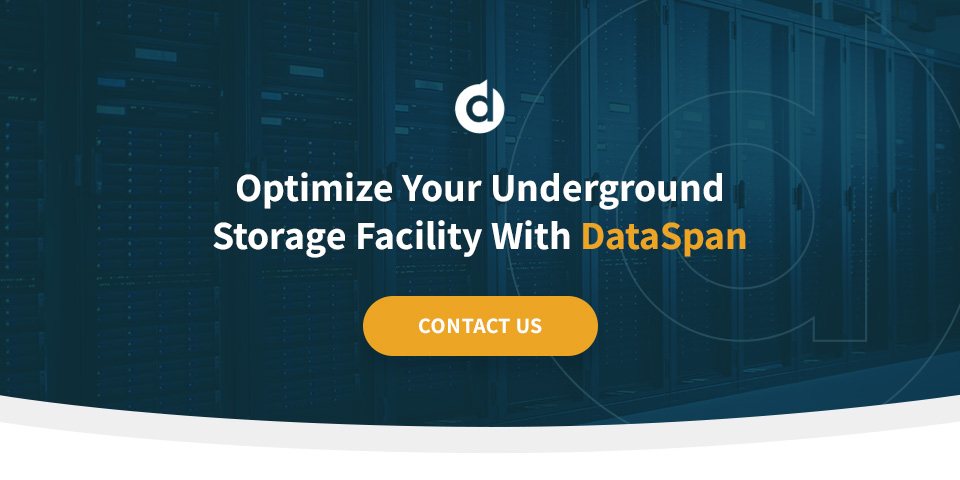
The Pros and Cons of Underground Data Centers
Data is a vital resource that businesses rely on in the increasingly digital world. Collecting and storing data within one network is an invaluable tool, but it’s not without risk. Data centers are the solution for storing sensitive information in a safe and reliable facility.
To obtain the ultimate level of protection, some companies are taking their data centers underground. Subterranean facilities achieve unique features that aren’t possible on the surface. Underground data centers could be the way of the future.
What Are Underground Data Centers?
Data centers are robust facilities that store valuable information networks for businesses and other organizations in a physical location. These buildings often contain rows of computer systems and IT equipment that are vital to their daily operations. As a result, data centers must be secure, reliable and efficient.
Underground data centers achieve the same purpose from below the Earth’s surface. Companies are building their facilities in retired limestone mines and caves to optimize their IT operations. Surrounded by solid rock with only one or two protected entrances, it’s clear why underground data centers are an appealing prospect. The inherent security is just one benefit that’s drawing more companies to underground data bunkers. However, organizations should consider many other aspects before opening a subterranean facility.
The Pros of Underground Data Centers
Underground data centers offer natural benefits that make them appealing for storing critical information. Firms should consider these underground data center pros:
1. Rapid Construction
A crucial component of constructing data centers is building a sturdy exterior to house the facility. Underground spaces already have a defined outer shell, which saves time and money. Contractors can develop the interior almost immediately.
Above-ground properties are also constrained by complicated zoning and regulations that require time-consuming permit applications and extensive paperwork. Underground structures often need only a single permit, allowing contractors to complete the work quickly. Time is money, so high speed is extremely valuable.
2. Project Savings
Above-ground data centers are often built from scratch, starting with the foundation and exterior structure. In solid stone caves and mining shafts, the exterior shell already exists. This advantage significantly reduces construction costs and provides sufficient infrastructure to build a data center grounding system.

On the surface, organizations build data centers to withstand harsh weather and natural disasters. Underground structures are naturally protected to save even more money.
3. Natural Protection
Subterranean data centers are 100 feet or more below the surface. The surrounding rock protects the facility from a multitude of natural disasters. Tornadoes, hurricanes and even earthquakes have almost zero effect on underground data bunkers. Although they’re inside the Earth, quakes and tremors are typically only felt on the surface. The natural material braces the facility and holds it in place.
4. Consistent Temperature
Underground data centers benefit from the layers of organic thermal insulation surrounding them, which saves money on HVAC and cooling equipment and reduces their overall emissions. The stable climate promotes energy efficiency by reducing the amount of cooling your center needs during peak operations.
In contrast, aboveground data centers must combat the combined impacts of climate change and rising demand — according to the Department of Energy (DOE), data center load growth is expected to double or even triple between 2024 and 2028. While innovative solutions, such as geothermal underground thermal energy storage (UTES) systems, could help alleviate some of this load, these technologies are likely to be inaccessible to many data centers until they become more commonplace.
5. Advanced Security
Protecting your data is vital to your business’s success and your customers’ safety. The most significant benefit of underground data centers is the unmatched security they can provide. The facility is surrounded by thick rock, leaving only a few entrances to thwart potential intruders. The built-in security will protect the data center from the outside, so you can focus your attention and resources on fending off digital threats online.
The Cons of Underground Data Centers
Underground data bunkers have many advantages over traditional digital storage facilities, but they also have unique challenges. Firms must likewise consider these underground data center cons:
1. Space Restrictions
With an above-ground building, expanding your facility is relatively easy. Underground properties are bound to their original size. Extending the square footage is costly and often impossible. Altering the existing space could impact the structural integrity.
If your underground network expands beyond the limitations of the space, you might have to consider moving your entire operation. Another alternative would be to open an additional facility in another location. To ensure you have room to innovate and grow, find an underground property with extra space to expand.
2. Abnormal Configurations
In addition to size restrictions, architects must also accommodate large stone columns that support the facility. When you’re storing large, square equipment, rounded edges and sloped floors can cause challenges.
If you take a strategic approach to the design process, you can plan to fill a large portion of the space with equipment. Developing in an existing underground structure, such as a mine or quarry, can help reduce time spent on design and construction by providing reliable supports.
3. Complex Ventilation
Underground properties typically have existing ventilation systems, especially if they were initially built for mining purposes. However, these systems may not be developed enough for the equipment you intend to install. Data servers are sensitive to high temperatures, so you may have to invest in a more advanced ventilation system to keep them cool. The naturally low temperatures will make it easier to maintain a stable climate.
4. Staff Safety
Underground properties have fewer access points — usually only one or two. While this is extremely valuable for maintaining a secure data center, it can be dangerous for staff members in an emergency.
However, the number of staff members required to run the facility at one time is reasonably low. For example, a typical U.S. data center requires only 50 full-time staff members, many of whom are contracted workers. A small crew could safely evacuate from only a few exit points.
Examples of Real Underground Data Centers
One of the most important parts of planning and constructing an underground data center is identifying an ideal site to build. Although finding the best site for an underground data center can be challenging, these companies used existing structures to speed time to market.
Cavern Technologies, Inc. in Lenexa
While it already offers clients more than 160,000 square feet of hosting space, the Cavern Technologies data center in the Meritex Caves still has the capacity to increase its available space by another 700,000 square feet.
The center is located 125 feet below the surface, providing a safe ambient temperature for data center equipment and sufficient infrastructure for growth and scalability. LightEdge, an American underground data center firm, acquired Cavern Technologies in 2021.
Intacture Data Center in Trento, Italy
Deep in the Italian Alps lies the Intacture Data Center, a new colocation facility with 5MW of capacity and approximately 1,000 racks. The ambient temperature in its mountainous location is consistently cool enough to provide essentially free cooling, and the mountain shelters the IT infrastructure from earthquakes, severe weather and other natural disasters.
This data center is unique because, unlike Iron Mountain, it shares space with an active mine. The San Romedio mine in Trento is part of a public-private partnership between the University of Trento and Trentino DataMine, and its location helps reduce both land consumption and energy costs.
Intacture will begin accepting colocation contracts in 2026. A Trentino Datamine spokesperson said the company may expand its data center services after it experiences initial success.
Is an Underground Data Center Right for You?
If your organization is planning to invest in data centers, an underground network might be worth considering. The construction costs are often far lower than above-ground facilities, and the built-in solid rock shell significantly shortens construction timelines. With data center demand rapidly growing along with AI and cloud usage, this quick start is essential for leveraging speed to market.
The subterranean temperatures could also save on operating costs. The naturally cool climate reduces the need for constant air conditioning even as the surface temperature keeps getting hotter. In an industry requiring a lot of power, an underground data center could help reduce energy consumption.
Underground data networks have built-in security to protect your critical information. Plus, your computers and other IT equipment are safe from natural disasters and other physical threats. Subterranean data centers are secure, reliable and efficient facilities for storing valuable information.
Optimize Your Underground Storage Facility With DataSpan
Moving your operations below ground is a substantial undertaking. DataSpan can help you streamline your infrastructure and management techniques to optimize your underground facility. We’ll provide custom solutions for any challenge, from equipment maintenance and building upgrades to IT operations.
Contact us today to discuss your needs with one of our experts.
Linked sources:
- https://www.mckinsey.com/industries/technology-media-and-telecommunications/our-insights/ai-power-expanding-data-center-capacity-to-meet-growing-demand
- https://www.nrel.gov/news/detail/program/2025/reducing-data-center-peak-cooling-demand-and-energy-costs-with-underground-thermal-energy-storage
- https://www.datacenterdynamics.com/en/news/us-defense-counterintelligence-and-security-agency-awards-iron-mountain-colocation-contract/
- https://www.datacenterknowledge.com/data-center-construction/the-world-s-first-data-center-in-an-active-mine
- https://www.datacenterdynamics.com/en/news/lightedge-acquires-underground-data-center-firm-cavern-technologies/

About the Author: Alex von Hassler’s long term focus is the continued testing, learning, and deployment of modern IT solutions. During his years as a DataSpan team member, his responsibilities grew from managing Salesforce CRM to improving system security, creating marketing initiatives, as well as providing continued support to the highly motivated and experienced team in an ever-changing industry. As DataSpan evolves to provide the best-fitting IT solutions to its customers, Alex von Hassler continues to hone his skills in the world of web-based ERP systems, security, and best customer engagement practices. Empowering such a dynamic team with the right tools provides him with enormous gratification.








